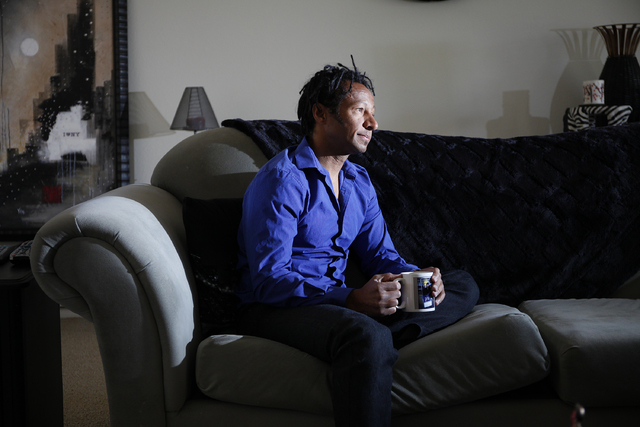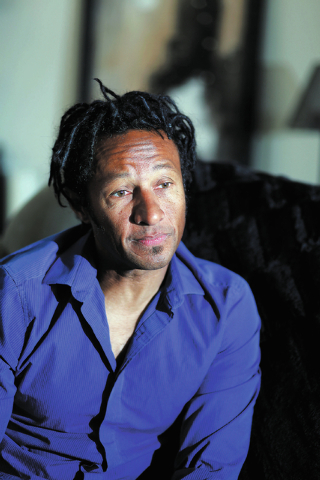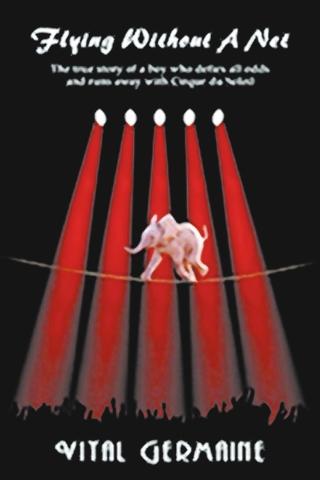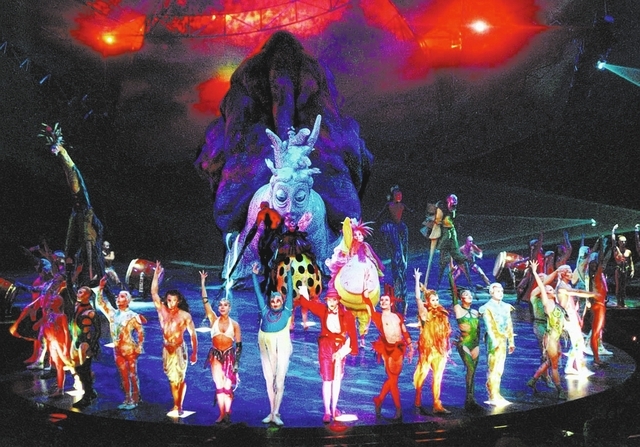Ex-acrobat tells of soaring with Cirque du Soleil, helping others reach dreams
Running away to join the circus usually brings to mind sawdust, three rings under big tops, performing animals and just generally that whole Toby Tyler vibe.
But when Vital Germaine ran away to join the circus, the experience was more about classy showrooms, world-class athletes, elaborate costuming and feats of skill no traveling circus aerialist could hope to duplicate.
For almost six years, Germaine was a Cirque du Soleil performer, first in the original cast of “Mystere” in Las Vegas and then in a national tour of another show. When injuries ended his performing career, Germaine was forced to create a new career as an entertainment producer, author and inspirational speaker.
Now, in his recently released memoir, “Flying Without a Net: The True Story of a Boy Who Defies All Odds and Runs Away with Cirque du Soleil” (Ink &Quill Publishers, $16.99), Germaine tells the story of his life. Anticipated as the first of a two-volume autobiography, much of it is about the personal challenges Germaine faced before Cirque came calling and, as he describes it, about the power of imagination and dreams.
Germaine was born in the Belgian Congo (later Zaire and now the Democratic Republic of the Congo) to a Caucasian father and an African mother. When he was 6 months old, and the country was in the midst of civil war, Germaine and his family fled, first to Belgium and then to London.
Germaine says he grew up against the backdrop of his father’s abuse and his mother’s alcoholism. When he was
7, several years after his father had separated from the family, Germaine was taken from his mother when authorities decided that she couldn’t properly care for him. For the next several years, he was a ward of the English child care system, living with 16 other children in a group home in conditions that he describes as cold, neglectful and “very bureaucratic.”
“It’s a cliche, but, yes, we ate porridge,” Germaine says, now able to smile at the memory.
But “it was not a happy environment,” he adds, noting that, statistically speaking, growing up in his crime-, drug- and gang-riddled neighborhood should have left him either in jail or dead by the age of 18.
Yet, even as a kid, Germaine says he knew that his life was meant to be more someday than it was then.
“As a kid, I lived in the world of dreams. I really did,” says Germaine, an outgoing, oft-smiling man who speaks with a British-ish accent owed to his exotic heritage. “I was an aspiring soccer player, and in my mind I was going to become the next Pele. So I realized that in order to achieve that dream, I have to pursue that dream, and doing drugs, drinking, becoming dysfunctional didn’t belong to my dream.”
Germaine says his mother, despite the challenges her alcoholism presented, taught him a profound lesson as a child.
“She reinforced the fact that whatever it is you want to become, you can,” he says.
Germaine also learned that his soccer skills — as a teenager, he would play on the Belgian national indoor youth team — earned him approval and respect.
“As a child, I was very good at soccer and people really liked me because I was good. So I guess that propelled me to, ‘OK, you always have a choice. Regardless of what we face, there is always a choice.’ So I had a choice: I could get attention by being dysfunctional, by being rebellious, or I could get attention at being good at something.”
Germaine also found solace in soccer.
“When I was kicking a ball,” he says, “the world was perfect.”
At 16, after the death of his mother, Germaine moved to Belgium to live in a small coastal town with his father and half-siblings. It was an emotionally dysfunctional environment, he writes, that included blurry physical and sexual boundaries and verbal attacks from his father. Five years later, Germaine moved out.
Then, he says, smiling, “I met a girl, fell in love and got sidetracked, and I’m introduced to the nightlife.”
There, he discovered a different sort of recognition, becoming well-known in the clubs for his talent at impersonating Michael Jackson. Germaine discovered that the applause he received from dancing was different, more satisfying, than the recognition he received from playing soccer.
“As an athlete, you belong to a team. As an individual you’re getting attention,” he says. “There’s something magical about being applauded.”
One day, a woman at the club asked him if he’d ever thought of dancing seriously. Germaine signed up for a dance class and found the transition from soccer to dancing “very painful.”
“Soccer and dance do not go hand-in-hand. One is small, explosive movement that lacks flexibility, the other is the opposite,” he says.
“Funny story: The very first time I took a dance class, I showed up in my soccer outfit, and the dancers there gave me leg warmers and a headband. So I’m a cross between David Beckham and Richard Simmons.”
Germaine continued to study theater and dance. Then, he says, “out of that came the desire: I wanted to come to America and I wanted to be in a Michael Jackson video. That became the plan, that I’m going to America and meet Michael Jackson.”
At 28, Germaine arrived in New York City with, he says, “nothing but a dream in my pocket.”
Why America? His brother already lived there, and, Germaine says, “everybody in the world looks at America as the land of opportunity, which it is.
“So there’s a delicious sense of irony that a Belgian national born in the Congo with a British accent pursues his American dream by way of a French circus.”
Three months later, after his visa expired, Germaine returned to Belgium to tie up loose ends, obtain a student visa and sell everything that he had. Then he came here for good.
He struggled for about a year and a half.
“(I was) broke, living in a ratty studio in Spanish Harlem and taking dance classes,” he said. “But I kept auditioning and just kept chipping away at the dream.”
He never did land a Michael Jackson video, but he did dance in a Carmen Electra video. While in New York, he auditioned for Cirque du Soleil, which then was putting together its first Las Vegas show, “Mystere.”
“A friend of mine said, ‘There’s a French-Canadian circus’ — she pronounced it all wrong — ‘and it’s looking for ethnic dancers. You should audition.’ So she pulled me to this audition and I thought it was a joke.
“So at the audition, I just clowned around — no pun — because it was a joke,” Germaine says, but “part of the process of becoming a performer is you end up doing all and every audition just for the experience, because you never know.”
He did the trapeze and the bungee cords and had fun at the audition. And when Cirque called a month later to offer him a job, he turned it down.
Then he caught a performance of Cirque’s “Saltimbanco.”
“(It was) magnificent,” Germaine says. “It was, like, just beyond anything my imagination ever could have conceived.”
Germaine assumed that he’d already lost his chance to perform in “Mystere.” But when the company called back to make the offer again, he said yes and was hired as a dancer and aerialist in “Mystere” in 1993.
Germaine — then performing under the name Vital Jacob — performed as an aerial acrobat and taiko drummer in “Mystere” for about five years. When he and his performing partner were let go after a revamp of the show, he toured in Cirque’s “Quidam” for almost a year. Then, at age 37, “I had a very unfortunate injury,” Germaine says. “I broke my leg and ankle and had several surgeries. So that was sort of an abrupt ending.”
Ending his tenure with Cirque was painful.
“I wallowed in self-pity for about two years,” Germaine says.
He became involved in children’s theater here. He started his own entertainment production business, creating shows for businesses and other clients all over the world. Two years ago, Germaine began presenting training programs and giving inspirational and motivational talks to corporate clients, helping to inspire clients with team-building and creativity-fostering lessons he had learned with Cirque and throughout his life.
Germaine says the memoir began to take form about a decade ago, mostly as “a cathartic experience” and a means of exorcising “some of the frustration” he felt while growing up. Then, from his first turns “dabbling” in a sort of diary, “it just kept going and going,” he says. “I put it aside for a couple of years and then sort of picked it up.”
Ultimately, Germaine says, “I think it’s a story that needs to be told and that should be told.”
He hopes his memoir, along with the volume that will follow — afterward, he plans to focus on inspirational and motivational books — will interest a diverse group of readers, be they Cirque du Soleil fans seeking a look into backstage life, adults who also experienced family conflict or dysfunction as kids, or those who simply wish to learn a few practical lessons they can use in their own lives.
Not to mention, perhaps, anybody who ever wanted to run away and join the circus.
“I do want to tell people what it’s like to run away to the circus and share some of what the backstage life is really like,” Germaine says. “Like any job, it is a job. It’s a glamorous job, a fabulous job, but it is a job nonetheless. But I wanted to share that excitement.”
Besides, Germaine says, “everybody has a story. We all have some challenges to overcome, and I like to think my story will inspire others to pursue their dreams, regardless of circumstances. That’s ultimately the message of the book: If there’s something you want to become and something you want to do, you do have the power, through your imagination, to make that happen, regardless of where you start.”
“It’s all connected to dreams,” Germaine says. “I daresay my imagination saved my life.”
Contact reporter John Przybys at jprzybys@review journal.com or 702-383-0280.






















